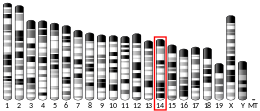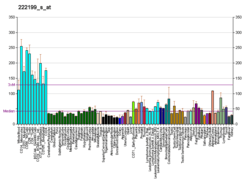Bridging integrator 3
Bridging integrator 3 is a protein that in humans is encoded by the BIN3 gene.[5][6]
Function
The product of this gene is a member of the BAR domain protein family. The encoded protein is composed solely of a BAR domain which is predicted to form coiled coil structures and proposed to mediate dimerization, sense and induce membrane curvature, and bind small GTPases. BAR domain proteins have been implicated in endocytosis, intracellular transport, and a diverse set of other processes.[6]
gollark: It could be semiautomated based on keywords (or, indeed, the criteria used to decide whether to have a conversation or not under your proposal), and disable it after, say, 15 minutes of no activity.
gollark: So, not working.
gollark: It didn't isolate all the NSFW stuff and it is dead now.
gollark: Except for not working, yes.
gollark: This would run into exactly the same issues as the proposed NSFW channel.
References
- GRCh38: Ensembl release 89: ENSG00000147439 - Ensembl, May 2017
- GRCm38: Ensembl release 89: ENSMUSG00000022089 - Ensembl, May 2017
- "Human PubMed Reference:". National Center for Biotechnology Information, U.S. National Library of Medicine.
- "Mouse PubMed Reference:". National Center for Biotechnology Information, U.S. National Library of Medicine.
- Ren G, Vajjhala P, Lee JS, Winsor B, Munn AL (Mar 2006). "The BAR domain proteins: molding membranes in fission, fusion, and phagy". Microbiol Mol Biol Rev. 70 (1): 37–120. doi:10.1128/MMBR.70.1.37-120.2006. PMC 1393252. PMID 16524918.
- "Entrez Gene: BIN3 bridging integrator 3".
External links
- Human BIN3 genome location and BIN3 gene details page in the UCSC Genome Browser.
Further reading
- Habermann B (2004). "The BAR-domain family of proteins: a case of bending and binding?". EMBO Rep. 5 (3): 250–5. doi:10.1038/sj.embor.7400105. PMC 1299016. PMID 14993925.
- Maruyama K, Sugano S (1994). "Oligo-capping: a simple method to replace the cap structure of eukaryotic mRNAs with oligoribonucleotides". Gene. 138 (1–2): 171–4. doi:10.1016/0378-1119(94)90802-8. PMID 8125298.
- Routhier EL, Burn TC, Abbaszade I, et al. (2001). "Human BIN3 complements the F-actin localization defects caused by loss of Hob3p, the fission yeast homolog of Rvs161p". J. Biol. Chem. 276 (24): 21670–7. doi:10.1074/jbc.M101096200. PMID 11274158.
This article is issued from Wikipedia. The text is licensed under Creative Commons - Attribution - Sharealike. Additional terms may apply for the media files.




